Fairmount Park is Philadelphia’s largest urban green space, spanning both sides of the Schuylkill River to deliver a combined 2,000 acres of public grounds. The Philadelphia Museum of Art and a collection of historic mansions lie within these verdant environs, which were initially designed by noted 19th-century landscape architects Robert Morris Copeland, Frederick Law Olmstead, and Calvert Vaux.
To enshrine the legacy of the U.S. Centennial Exposition, which occurred in the park in 1876, the city built the John Welsh Memorial Fountain in 1887, honoring the chairman of the exhibit’s board of finance. Positioned on the site of the centennial’s demolished main exhibition hall, the fountain and surrounding garden front the Beaux Arts-style Memorial Hall, the largest remaining structure from the exhibition.
The Welsh Fountain sits at the intersection of two perpendicular pedestrian paths and four grass lawns. Once a popular public space, the memorial fell into disrepair in the 1970s. Today, the space lacks proper shade, seating, and nighttime lighting, suffering from a general lack of upkeep. The most potent symbol of this neglect is the state of the central fountain, which has remained dry for decades.
On June 2, the Fairmount Park Conservancy announced a restoration of the memorial, led by landscape architects Nelson Byrd Woltz. The new design is informed by community input and engagement with the adjacent Parkside neighborhood, adding new seating, tree plantings to promote shade, improved pedestrian infrastructure, and children’s play areas, while also providing for the fountain’s restoration.
“This project is an opportunity to restore not just the historic fountain, but also a vital gathering place for the Parkside neighborhood,” Thomas Woltz, the firm’s senior principal, said in a statement. “By carving out spaces where local artists can showcase their work, quiet places for the community to gather, and areas for kids to play and learn about the site’s incredible history, we wanted to ensure that this landscape can once again support connection, celebration, and a sense of belonging for all,” he added.

The project team will plant native shrubs, perennials, and trees on the interior lawns of the memorial. Currently, the only shade canopy is provided by a row of trees on the periphery of the site. New uses will also activate four disused circular plant beds at the center of each lawn, adding climbable boulders and water features for play, as well as public seating areas. These additions will engage both locals and families visiting the Please Touch Museum, a children’s museum that occupies Memorial Hall.
As part of the plan, the city will narrow surrounding roadways to improve pedestrian safety and simultaneously upgrade stormwater infrastructure. These efforts build upon previous city initiatives to better integrate West Fairmont park with Parkside, including the nearby Parkside Edge project, a recently improved intermediary space that now hosts a number of publicly programmed festivals and events.

This sensitivity to the memorial’s urban context extends to new signage that tells the history of Parkside, as well as public art installations and murals commissioned from community members and local artists.
“Our goal in West Fairmount Park is to invest in the often-overlooked basics of park infrastructure and develop park features that enhance visitor safety and enjoyment—and to do so in continual partnership with the local neighbors for whom the park should feel like home,” said Tim Clair, interim CEO of the Fairmount Park Conservancy.
The project’s estimated completion date is spring 2027.
→ Continue reading at The Architect's Newspaper
